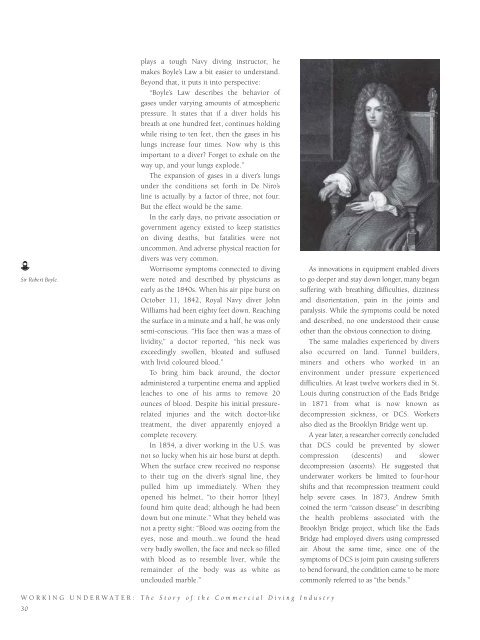Working Underwater: The Story of the Commercial Diving Industry
An illustrated history of the commercial diving industry paired with the histories of companies that have helped shape the industry.
An illustrated history of the commercial diving industry paired with the histories of companies that have helped shape the industry.
You also want an ePaper? Increase the reach of your titles
YUMPU automatically turns print PDFs into web optimized ePapers that Google loves.
Sir Robert Boyle.<br />
plays a tough Navy diving instructor, he<br />
makes Boyle’s Law a bit easier to understand.<br />
Beyond that, it puts it into perspective:<br />
“Boyle’s Law describes <strong>the</strong> behavior <strong>of</strong><br />
gases under varying amounts <strong>of</strong> atmospheric<br />
pressure. It states that if a diver holds his<br />
breath at one hundred feet, continues holding<br />
while rising to ten feet, <strong>the</strong>n <strong>the</strong> gases in his<br />
lungs increase four times. Now why is this<br />
important to a diver? Forget to exhale on <strong>the</strong><br />
way up, and your lungs explode.”<br />
<strong>The</strong> expansion <strong>of</strong> gases in a diver’s lungs<br />
under <strong>the</strong> conditions set forth in De Niro’s<br />
line is actually by a factor <strong>of</strong> three, not four.<br />
But <strong>the</strong> effect would be <strong>the</strong> same.<br />
In <strong>the</strong> early days, no private association or<br />
government agency existed to keep statistics<br />
on diving deaths, but fatalities were not<br />
uncommon. And adverse physical reaction for<br />
divers was very common.<br />
Worrisome symptoms connected to diving<br />
were noted and described by physicians as<br />
early as <strong>the</strong> 1840s. When his air pipe burst on<br />
October 11, 1842, Royal Navy diver John<br />
Williams had been eighty feet down. Reaching<br />
<strong>the</strong> surface in a minute and a half, he was only<br />
semi-conscious. “His face <strong>the</strong>n was a mass <strong>of</strong><br />
lividity,” a doctor reported, “his neck was<br />
exceedingly swollen, bloated and suffused<br />
with livid coloured blood.”<br />
To bring him back around, <strong>the</strong> doctor<br />
administered a turpentine enema and applied<br />
leaches to one <strong>of</strong> his arms to remove 20<br />
ounces <strong>of</strong> blood. Despite his initial pressurerelated<br />
injuries and <strong>the</strong> witch doctor-like<br />
treatment, <strong>the</strong> diver apparently enjoyed a<br />
complete recovery.<br />
In 1854, a diver working in <strong>the</strong> U.S. was<br />
not so lucky when his air hose burst at depth.<br />
When <strong>the</strong> surface crew received no response<br />
to <strong>the</strong>ir tug on <strong>the</strong> diver’s signal line, <strong>the</strong>y<br />
pulled him up immediately. When <strong>the</strong>y<br />
opened his helmet, “to <strong>the</strong>ir horror [<strong>the</strong>y]<br />
found him quite dead; although he had been<br />
down but one minute.” What <strong>the</strong>y beheld was<br />
not a pretty sight: “Blood was oozing from <strong>the</strong><br />
eyes, nose and mouth...we found <strong>the</strong> head<br />
very badly swollen, <strong>the</strong> face and neck so filled<br />
with blood as to resemble liver, while <strong>the</strong><br />
remainder <strong>of</strong> <strong>the</strong> body was as white as<br />
unclouded marble.”<br />
As innovations in equipment enabled divers<br />
to go deeper and stay down longer, many began<br />
suffering with breathing difficulties, dizziness<br />
and disorientation, pain in <strong>the</strong> joints and<br />
paralysis. While <strong>the</strong> symptoms could be noted<br />
and described, no one understood <strong>the</strong>ir cause<br />
o<strong>the</strong>r than <strong>the</strong> obvious connection to diving.<br />
<strong>The</strong> same maladies experienced by divers<br />
also occurred on land. Tunnel builders,<br />
miners and o<strong>the</strong>rs who worked in an<br />
environment under pressure experienced<br />
difficulties. At least twelve workers died in St.<br />
Louis during construction <strong>of</strong> <strong>the</strong> Eads Bridge<br />
in 1871 from what is now known as<br />
decompression sickness, or DCS. Workers<br />
also died as <strong>the</strong> Brooklyn Bridge went up.<br />
A year later, a researcher correctly concluded<br />
that DCS could be prevented by slower<br />
compression (descents) and slower<br />
decompression (ascents). He suggested that<br />
underwater workers be limited to four-hour<br />
shifts and that recompression treatment could<br />
help severe cases. In 1873, Andrew Smith<br />
coined <strong>the</strong> term “caisson disease” in describing<br />
<strong>the</strong> health problems associated with <strong>the</strong><br />
Brooklyn Bridge project, which like <strong>the</strong> Eads<br />
Bridge had employed divers using compressed<br />
air. About <strong>the</strong> same time, since one <strong>of</strong> <strong>the</strong><br />
symptoms <strong>of</strong> DCS is joint pain causing sufferers<br />
to bend forward, <strong>the</strong> condition came to be more<br />
commonly referred to as “<strong>the</strong> bends.”<br />
WORKING UNDERWATER: <strong>The</strong> <strong>Story</strong> <strong>of</strong> <strong>the</strong> <strong>Commercial</strong> <strong>Diving</strong> <strong>Industry</strong><br />
30
















